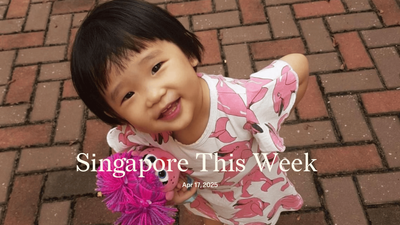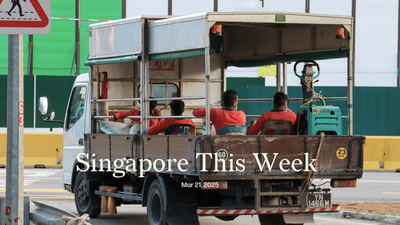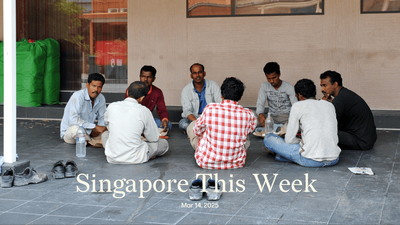Society: Land use to prioritise the wider community
News that the government will not be renewing Raffles Town Club’s lease after it expires in 2026 has rekindled the debate about allocating land for privileged use in land-scarce Singapore. In a CNA commentary, Sing Tien Foo from the National University of Singapore’s Business School, wrote that it wasn’t unusual for authorities “to let leases lapse and to rezone land to benefit the wider community.” In 2020, for example, owners of 191 private terrace houses at Lorong 3 Geylang had to vacate their homes, after their land was returned to the state—now slated for public housing development. Recently, more than 60 Lim Chu Kang farmers were forced to move out to make way for military use. Still, when it comes to country clubs, it’s also imperative to question their continued relevance. Membership numbers have dwindled over the years and country club management have had to find new ways—besides having a pool, gym and tennis court—to attract and retain new members. Young Singaporeans no longer consider the 5Cs—cash, car, credit card, condominium and country club membership—as essential to achieving the Singapore Dream. When it comes to land allocation more generally, Singaporeans are increasingly concerned with questions over fair distribution, sustainability and environmental conservation. Even though Raffles Town Club doesn’t have one, golf courses are the main sites of contention. They benefit the few who can afford to use them, but cover some 1,500 hectares of land. Why not redevelop them instead of clearing our forests to make way for housing? Rachel Ong, a People’s Action Party member of Parliament, argued that forests should be considered a “last resort”, and that it would be “ecologically responsible” to look to Singapore’s 17 golf courses to solve our development needs. “While future generations can choose to rebuild golf courses, forests that are now removed will take decades to grow and the connected biodiversity that we lose now may never return,” she said. Words to heed, indeed.
Some additional reading:
“Our farmland, a world lost”, about the final days at Fireflies Health Farm.
“One person’s quest to save Dover Forest”, about the final days at Dover Forest East.
Society: A teenage love tragedy highlights the need for better sex ed
The Singaporean courts have just presided over a tragic teenage love story, which involves some harrowing details about a failed abortion. In May 2020, at the start of the pandemic, a 14-year-old boy and a 15-year-old girl, secondary school classmates, began a romantic and sexual relationship. In January 2021, they discovered that they were pregnant. They tried to abort the foetus on their own using methods they found online: inserting a clothes hanger into her body to yank the foetus out; taking abortion pills; and having the boy punch and knee her in the abdomen. All failed. And so on June 10th 2021, during one of Singapore’s pandemic lockdowns, she delivered their stillborn baby in her room, in the company of her boyfriend over video call. She cut the umbilical cord with scissors, wrapped the body in newspaper, and hid it in her cabinet. Her boyfriend told her that it was safer to bury it in the garden of her home. She did so, and would occasionally sit by the grave to grieve. After their relationship ended in March 2022, the girl’s mother found out what had happened, and a police report was filed. The girl has been given a conditional warning for her role in the case, according to The Straits Times (ST). It’s still unclear what kind of punishment the boy, who’s been found guilty, will face: possibly probation, or the more serious reformative training, which will result in a criminal record. According to ST, for abetting the concealment of birth by secret disposal of a body, an offender can be jailed for up to two years, or fined, or both; and for sexual penetration of a minor, an offender can be jailed for up to 20 years and fined or caned. The boy did not use condoms while having sex with his girlfriend, the prosecutor said, because he found them difficult to buy because of his age. (Even though there is no minimum age for purchasing condoms in Singapore, it’s not easy for minors to do so.) The facts of the case suggest that one issue here could be a societal failure to equip young people with the sexual education and emotional maturity they need to handle the challenges of puberty. Love, sex, and procreation are gifts in this life; and this tragedy should remind us that the boy, girl, and baby are perhaps victims of circumstance.
Internet culture: The rizz-ler is coming to town
“Rizz” is the word of the year, according to Oxford University Press (OUP). Short for charisma, “rizz” beat out words like “situationship” (an informal, label-less romantic relationship, which is as messy as it sounds), “Swiftie” (self-explanatory, if you’ve been on the internet this year) and “de-influencing” (the process of discouraging people from buying hyped-up products). Compared to previous words of the year, like “vax” in 2021 and “goblin mode” in 2022, “rizz” reveals a more optimistic mood, one where “more of us are opening up after a challenging few years and finding confidence in who we are”, said Casper Grathwohl, president of Oxford Languages. “Rizz”, like most internet slang, transcends grammar rules—it can be used as a noun (“rizz-ler”), verb (“rizz up”), or adjective (“rizz lines”). Specifically used to describe someone smooth and charming in a romantic context, “rizz” originated from New York slang but went viral when Tom Holland, aka Spiderman, claimed he has “no rizz whatsoever” in an interview about his girlfriend Zendaya. “...stories of linguistic evolution and expansion that used to take years can now take weeks or months,” said OUP, emphasising the role of Gen Zs on social media in shaping our everyday language. But before you add “rizz-ler” to your Instagram bio, remember the wise words of Tom Hanks: “If you claim to have rizz, that means you don’t have it.”
History weekly by Faris Joraimi
This time last year, I tried to keep things light for Jom’s last weekly round-up before Christmas and the new year. But as many have expressed online, it’s hard to be in good cheer with mass killing in the Holy Land. The US recently vetoed a major instrument available to the UN General Assembly known as Resolution 377, or “Uniting for Peace”. Representing most of the world’s population, the General Assembly is the largest but also the weakest organ of the UN. Yet in theory, 377 enables them to overcome gridlock in the all-powerful Security Council, if its five permanent members (China, France, Russia, the UK and US, who were the “victors” of world war two) fail to act in the interest of international peace. I’m relieved that Singapore stood with most of the international community to try and stop Israel’s aggression by voting in favour of 377. Ironically, the first time 377 was invoked—in 1956—was also in response to an invasion by Israel, together with Britain and France, against Egypt and the Gaza Strip. In what’s now known as the Suez Crisis, the Egyptian president Gamal Abdel Nasser nationalised the Suez Canal, located within Egypt’s borders but then under Anglo-French control. He was acting in the geopolitical context of the Cold War and the expulsion of European colonialists from Arab lands. The US sought a diplomatic solution, but the Anglo-French-Israeli forces retaliated by capturing Suez, the Sinai peninsula and Gaza. They met with worldwide condemnation. Britain and France vetoed attempts at the UN to stop the war, so Resolution 377 was invoked, with the General Assembly adopting the US’s proposal for a ceasefire and the withdrawal of troops. The proposal was implemented, delivering a political triumph for Nasser; the Canal is still Egyptian-run today. A legally non-binding recommendation, 377 only seems to work if members of the Security Council (especially the US) agree to implement it. With the recent veto, thousands more Palestinians will likely be killed by Christmas, a time to commemorate the radical hope of a child also born, under occupation, in Bethlehem (today part of the West Bank, in “Area A”: the Palestinian zones with the most autonomy from Israel). It will probably be Christmas as usual in Singapore, but I will be thinking of what Munther Isaac, a Palestinian Christian theologian wrote recently on Instagram: “In Gaza today, God is under the rubble. He is in the operating room. If Christ were to be born today, he would be born under the rubble.” May our thoughts never abandon the oppressed.
Arts: Two exhibitions to end and begin the year with
Two blockbuster exhibitions—one an ambitious intercontinental survey, the other a specific mid-career showcase—will close this year and open the next. “Tropical”, the National Gallery Singapore’s overture to Latin America by way of South-east Asia, knits together aesthetic and political preoccupations in both regions, from struggles against colonialism to assertions of independence to visions of what a regional visual identity might be. Syed Hussein Alatas and Pramoedya Ananta Toer, two South-east Asian critical theory and literary giants, give the show its conceptual arc, with galleries titled after their respective seminal books: The Myth of the Lazy Native (1977) and This Earth of Mankind (1980). Here, a self-portrait by Mexican legend Frida Kahlo (1907-1954) archly apprehends the viewer alongside another more pensive portrait by Malayan painter Patrick Ng Kah Onn (1932-1989). The two contemporaries may have never met, but now both gaze back at us, side by side. This comparative exhibition is reflective of a growing interest among artists and academics to investigate the links between Global South sites, including Afro-Asian networks. The 2021 show “In Our Best Interests: Afro-Southeast Asian Affinities during a Cold War”, co-curated by Kathleen Ditzig and Carlos Quijon Jr., also interrogated postcolonial aspirations for a “global solidarity”, which is echoed less sceptically in the vocabulary of the National Gallery exhibition. And the Asian Civilisations Museum’s ongoing “Manila Galleon: From Asia to the Americas” (which Jom wrote about a few weeks ago), engages with maritime trade between Manila and Mexico circa the 16th century. Over at the Singapore Art Museum, “Time & the Tiger” marks 20 years of Singaporean artist Ho Tzu Nyen’s interdisciplinary practice, one that continues to embrace multiple temporalities and repeated motifs (the tiger, memory, war) across mediums such as video and installation. Ho is himself invested in mythic, philosophical and visual conceptions of South-east Asia. Featured in this retrospective is his decade-long project The Critical Dictionary of Southeast Asia (2012-ongoing), which asks: “What makes South-east Asia a unified region when it has never been bound by a single religion, language or political system?” His intellectual explorations have also extended to Pan-Asian philosophical frameworks, particularly the syncretic Kyoto School whose controversial work would eventually bolster Japan’s imperialist and militarist project during the Pacific War (1941-1945). Through his intricately plotted and hallucinatory film installations, Ho offers us multiple visions of history, all haunted by conflicting ideologies, shifting frames of reference and asymmetrical vantage points. All these museum and gallery shows run concurrently from November till March next year, as the Singapore arts industry gears up for January, the busiest calendar month for visual and cross-disciplinary artists as they wrestle with the tentacular creature the upcoming Singapore Art Week has become.
Tech: State of venture building in Singapore
Start-ups in emerging technologies often struggle to access funding and expertise. To help, investment firms have launched venture builders to co-found start-ups with proven entrepreneurs, providing initial funding, sector research and expert networks. They’ve had mixed success. Temasek, has faced challenges with three of its venture-build start-ups: GoodWorker, Trustana, and Affinidi. These setbacks resulted in significant staff layoffs and reorganisation in 2023. GoodWorker, a blue-collar job platform, discontinued operations, laying off most of its staff with the remainder absorbed by Affinidi. Temasek wrote off its investment and recorded an impairment loss of US$17.6m (S$23.6m). Trustana experienced staff attrition after shifting from being a B2B cross-border marketplace to a SaaS (software as a service) product. Despite receiving significant funding, Trustana concluded 2022 with major losses and limited cash in the bank. Affinidi also saw employee exits following a voluntary separation scheme, but appears to be hiring again, notwithstanding a 60 percent year-on-year increase in its net losses in 2022. However, the troubles faced by these companies don’t necessarily spell doom for Temasek’s venture building strategy. With 12 more start-ups launched since 2020 and plenty of money to invest, they are still primed to produce successful ventures in diverse industries. From an investor perspective, venture builders continue to attract interest from institutional funds globally, as seen by the recent oversubscribed US$60m (S$80.6m) fundraise by Wavemaker Impact (WMI), the first climate tech venture builder in South-east Asia, exceeding its original target of US$25m (S$33.5m). WMI has initiated and invested in six companies, in areas such as biochar, solar mortgages and regenerative agriculture. And it’s working towards its 10th investment by this year’s end, while launching its first operations in Australia and India.
Tech: Can Singapore build a large language model for South-east Asia?
Inspired by the success of OpenAI and wanting to cement its Artificial Intelligence (AI) dominance in the region, Singapore announced the National Multimodal LLM (large language model) Programme (NMLP). Funded by the National Research Foundation, and backed by the National Supercomputing Centre, this S$70m initiative will bolster the nation’s AI research capabilities with a focus on multi-modal LLMs. The two-year, national-level initiative aims to support Singapore’s National AI Strategy 2.0 (NAIS 2.0), which targets nurturing Singapore into a global AI solutions leader by 2030. To achieve this, the NMLP will develop crucial AI talent, foster a thriving AI industry, and create a trusted environment for AI use, which includes understanding unique linguistic characteristics of the region. NMLP will refine the SEA-LION model, an open-source large language model designed to be affordable and adaptable, which reflects South-east Asia’s distinct cultural contexts and linguistic nuances. It aims to better represent the region and manage linguistic context-switching. Various players in the technology ecosystem believe that this could be a waste of resources: Western-centric models can already understand Singlish, lah. Furthermore, one concern among several is that S$70m may be insufficient to build a model that is 10 times larger in parameters than the existing SEA-LION model from AI Singapore. Yet, there could be larger strategic imperatives behind the government’s decision to invest significantly in AI, especially to create more AI-related jobs and attract adjacent companies such as NVIDIA to bolster their presence here.
If you enjoy Jom’s work, do get a paid subscription today to support independent journalism in Singapore.







